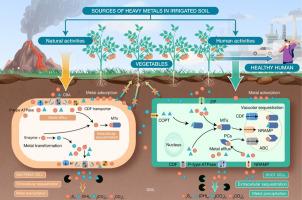Assessment of heavy metals pollution in vegetables grown on irrigated soil and their potential threat to human health and global food security
IF 2.7
引用次数: 0
Abstract
Heavy metals accumulation in vegetables grown on irrigated soils are affected by human-and natural activities. They represent a serious global concern due to the presence of harmful elements in the water used for irrigation that later accumulate in the soil at high level, affecting soil quality, crops and human health. Within the rhizosphere, metals severely affect microbiome and vegetables physiological function, which can compromise vegetable qualities and through their accumulation present a serious threat to consumers. Factors that influence heavy metal availability include the pH, organic matter, crop- and microbial deposits. Plant and associated symbiotic bacteria have evolved strategies to mitigate metal bacterial secretion into rhizosphere, including the siderophores, phytohormones, antibiotics, mucilage, organic acids, phenols, polypeptides, exopolysaccharides (EPS), as well as inorganic ligands such as NH4+, PO43-, and more may chelate heavy metal ions, desirable to decrease the availability and the uptake of heavy metals in plant and bacteria, potentially beneficial to plants and humans. This review focuses on the source of heavy metals in irrigated soils where vegetables are grown, mobility/availability of metals in such soil, uptake/accumulation by the plant, toxicity of these heavy metals to vegetables and human, and the mitigation strategies used by plants and bacteria to reduce the impact of metals on humans via the food chain.

灌溉土壤蔬菜重金属污染评价及其对人类健康和全球粮食安全的潜在威胁
在灌溉土壤上种植的蔬菜中重金属的积累受到人为和自然活动的影响。由于用于灌溉的水中存在有害元素,这些元素后来在土壤中大量积累,影响土壤质量、作物和人类健康,因此它们引起了全球的严重关切。在根际内,金属会严重影响微生物组和蔬菜的生理功能,从而影响蔬菜的品质,并通过其积累对消费者构成严重威胁。影响重金属有效性的因素包括pH值、有机物、作物和微生物沉积物。植物及其相关共生细菌已经进化出减缓金属细菌向根际分泌的策略,包括铁载体、植物激素、抗生素、粘液、有机酸、酚类、多肽、外多糖(EPS),以及无机配体如NH4+、PO43-等可能螯合重金属离子,有助于降低植物和细菌对重金属的可利用性和吸收,对植物和人类都有潜在的益处。本文综述了蔬菜灌溉土壤中重金属的来源、金属在土壤中的流动性/有效性、植物对重金属的吸收/积累、这些重金属对蔬菜和人类的毒性以及植物和细菌通过食物链减少金属对人类影响的缓解策略。
本文章由计算机程序翻译,如有差异,请以英文原文为准。
求助全文
约1分钟内获得全文
求助全文
来源期刊

Hygiene and environmental health advances
Environmental Science (General)
CiteScore
1.10
自引率
0.00%
发文量
0
审稿时长
38 days
 求助内容:
求助内容: 应助结果提醒方式:
应助结果提醒方式:


